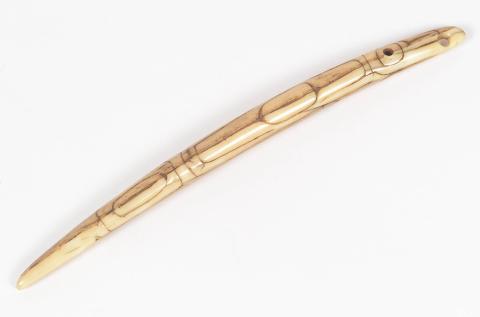Old Ivory Amulet
This piece is carved in an archaic style with unusual iconography and is probably much older than what has been recorded by the museum. Steve Brown who is a scholar of Tlingit art thinks that the item is from the early 1700’s and had been handed down through the generations. One of the most important functions of an Íxt’ was to heal people of their village. They knew how to prepare herbal cures, had skill in surgery, and helped during childbirth. In addition to healing the sick they could communicate with the spirit world, solve difficult complex problems, remove spiritual harm, locate missing people, locate plentiful food sources, advise on military decisions, predict the future and the weather. The list of responsibilities that an Íxt’ would be expected to provide is much larger and varied than what’s listed. From the examples given it is clear to see how important the role of an Íxt’ is to the health and wellbeing of a Tlingit community.
The days of the Íxt’ have long passed however, modern medicine is now showing that the susceptibility to diseases and the recovery from diseases are linked to the emotional and mental state of the patient, something the Íxt was aware of as they established a relationship with their patient where they convinced the patient to believe and participate in their own healing. What was old then is now new.
An Íxt’ had much more freedom to create artistic objects for use in their ceremonies and lifestyle than the average Tlingit person. Social mores were relaxed for an ĺxt’ because of their supernatural power and connections. Nobody challenged an ĺxt’ about the composition or iconography of their art. Their art for lack of a better term in English is very distinctive, powerful and at times fear inducing. Amulets were common and were imbibed with spiritual power, they were usually pierced and could be worn as a single object or grouped with other amulets around the neck or waist. At times amulets were sewn on to leather aprons also that were used during certain ceremonies.
Íxt’ items were sacred and had connections with the spirit world. Even after the death of an Íxt’ their objects still contained the power they had while the Íxt’ was still alive. Only another Íxt’ or the deceased Íxt’s helper could move or handle these objects. Most of the time these remained with the bones of the deceased Íxt’ both contained in a special ossuary bentwood box that remained above ground. Íxt’ remains were placed in a strategic location where the spirit of the Íxt’ could oversee the village and the access routes to the village. A special grave house was built just for the Íxt’, unlike other people they were not cremated their body was to remain above ground. If common people had to handle an Íxt’s remains they had to go through special procedures, ceremonies, and purification for before and after exposure to the remains, at times even for the objects owned by the Íxt’.
Collected by Lieutenant George T. Emmons (1852-1945, US Navy 1881-1899) at an unknown date; purchased by George Heye from George T. Emmons in 1915.

